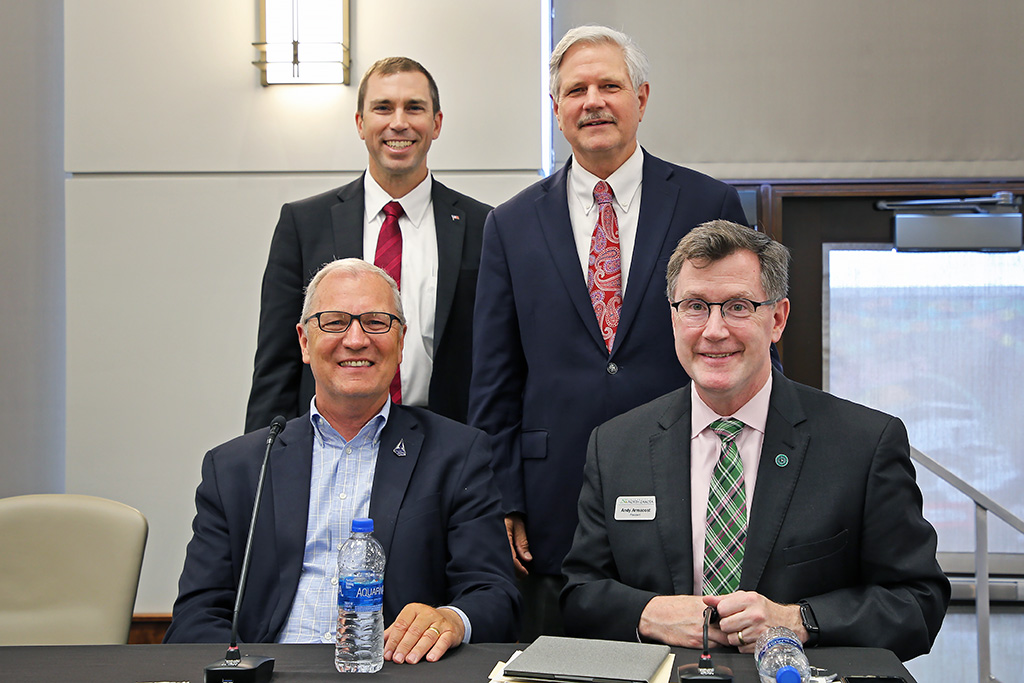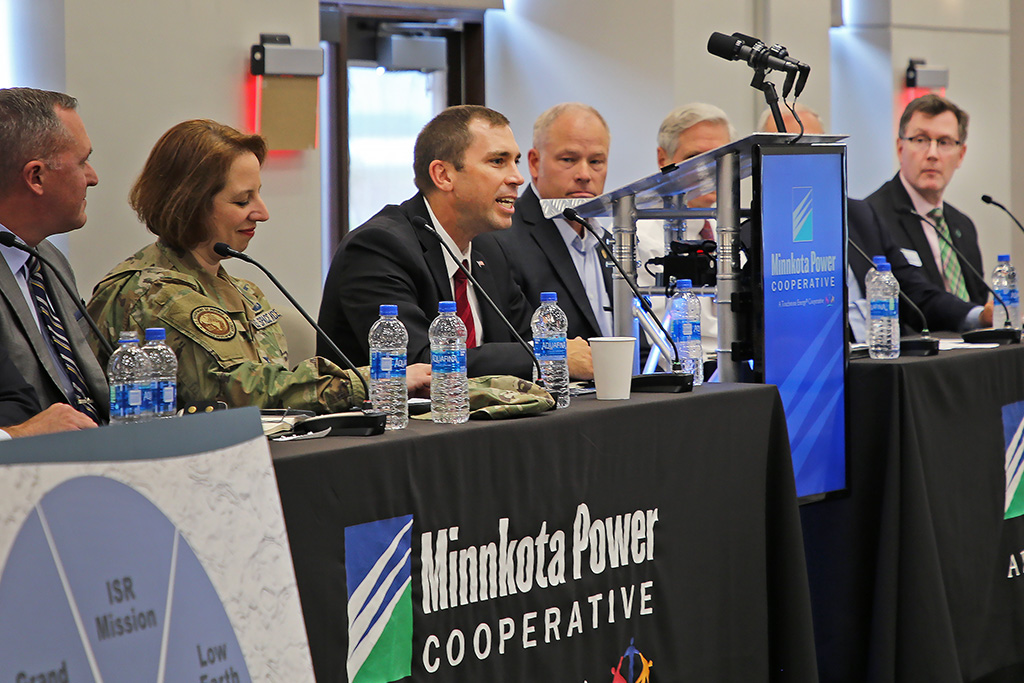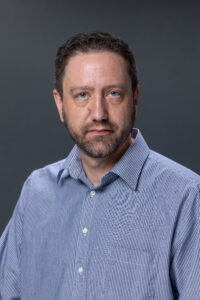Approaching escape velocity
UND’s space ecosystem continues to grow, as shown by U.S. Space Development Agency’s new satellite initiative

Members of North Dakota’s congressional delegation visited Grand Forks Air Force Base on Tuesday, June 28, along with national space experts and UND President Andrew Armacost, for a ribbon cutting ceremony commemorating the U.S. Space Development Agency’s latest initiative in the state.
The ceremony marked the selection as GFAFB as the site of the SDA’s Space Networking Center, a facility that will be used to support a low-Earth-orbit satellite mission which will serve as the backbone for U.S. military communications across the globe. Following the ceremony, attendees gathered for a community discussion of the new space mission at Minnkota Power Cooperative, in a follow-up event sponsored by the Greater Grand Forks Chamber of Commerce.
The high-tech facility is the most recent initiative in the North Dakota space and unmanned systems ecosystem. It follows upon the recent announcement, reported in the Grand Forks Herald, that 20 retired Global Hawk drones will be transferred in the coming weeks to drone business park Grand Sky, located near GFAFB. The Global Hawks will be adapted to be used for hypersonic missile testing in a program called Sky Range.
“The SDA’s Space Networking Center, which will be developed by General Dynamics, Iridium, Raytheon and other partners, will place North Dakota at the center of U.S. space operations,” said Hoeven, R-N.D. “Further, the LEO satellite mission and the Sky Range hypersonic missile testing program are two more strong examples of the partnerships we’ve established to secure Grand Forks’ role in the future of our nation’s defense. These new operations greatly complement GFAFB’s leadership in the Air Force’s (Intelligence, Surveillance and Reconnaissance) efforts, as well as the dynamic, world-class UAS industry we’ve built in the Red River Valley.”
Also in attendance Tuesday were Rep. Kelly Armstrong, R-N.D., and Derek Tournear, director of the SDA. Tournear has previously visited the state to discuss with University leaders and state lawmakers space-related initiatives including the LEO satellite mission.
“It seems like just yesterday I brought SDA Director Tournear to Grand Forks to show off our Airmen and University,” said Sen. Kevin Cramer, R-N.D. “Now here we are, less than two years later, cutting the ribbon on SDA’s first operations center. As the home of SDA’s first operations center, Grand Forks Air Force Base plays a critical role in bolstering our national security through its important satellite mission. This is also a tremendous opportunity for the entire community in terms of opening up new jobs for the area and working with the city’s academic and technology community. North Dakota’s space assets and capabilities are second to none and our excellence will be a boon to improve our nation’s space-based defense.”
The $325 million SDA contract was awarded to General Dynamics Missions Systems, Iridium and Raytheon to establish the facility at GFAFB, as well as a similar facility at Redstone Arsenal in Alabama. The GFAFB center is expected to be up and running by mid-2024.
UND: Initiatives actual and potential
At the community discussion, Armacost congratulated Tournear on the establishment of the networking facility. He said UND fully supports the mission to develop the networking center through its own space and national security initiatives, which include partnering with the U.S. Space Force for basic and applied research and workforce development needs.
Armacost said he envisions, and has discussed with Tournear, a similar satellite networking center at UND that can be used to test new forms of autonomy and command and control systems.
“When I see how far we’ve come in the last few years, I consider the need for rapid innovation in space technology and UND’s role in doing this,” Armacost said.
Tournear said such a satellite operations facility could function in a manner much like the way flight simulators work for UND aviation students. A dedicated training facility would not only help create a pipeline of people able to work in satellite operations but would be a center for developing the technology needed to allow people to operate potentially hundreds of satellites at a time.
“The only way you’re going to do that is to push a lot of this artificial intelligence and machine learning to be able to do that automated network,” Tournear said. “That’s a field where we really have to develop all the tools and do the research to develop those algorithms. That’s what UND is actually leading.”

Along with the dedication of the Space Networking Center comes several UND efforts to support space and national security issues:
The John D. Odegard School of Aerospace Sciences is installing a new space operations center classroom for orbital mechanics and space situational awareness. The College is also creating new graduate courses on space propulsion and hypersonic technologies. In development is a new satellite tracking station, which will include a remote-user interface for our distance-learning students.
The College of Arts & Sciences has added two new faculty positions in satellite engineering and military space and is working to establish a nanofoundry by 2023 to forge nanoscale devices of interest to the space community. The College will also be hiring additional faculty for space-related research in the areas of artificial intelligence, neural networks, chemistry and materials science with novel properties for space and aerospace applications. In collaboration with the aerospace school and UND’s Department of Psychology, Arts & Sciences is also exploring human/machine teaming.
Within UND’s College of Engineering & Mines, the School of Electrical Engineering & Computer Science will, this fall, break ground for a National Security Corridor at which satellite development, fabrication and testing will take place.
The College of Engineering has begun multiple research initiatives with potential direct connections to SDA’s mission in the areas of artificial intelligence, cybersecurity, energy and novel materials. Under UND’s National Security Initiative, eight faculty members have been or will be hired across three colleges to support research – with a special focus on space research.



